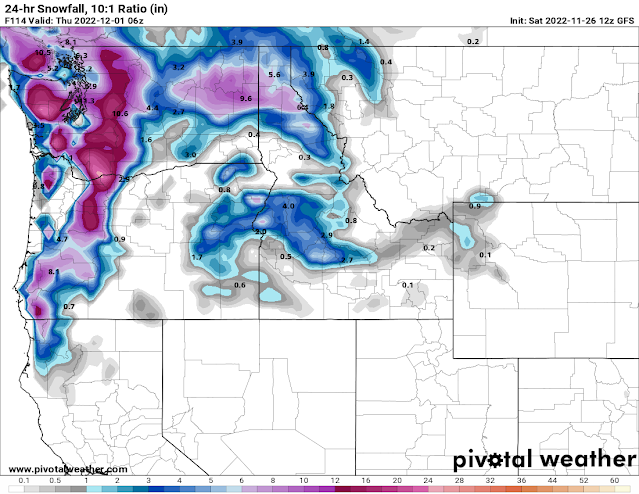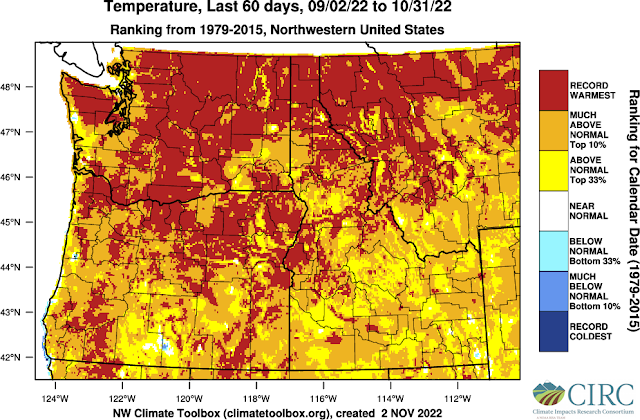There's a good chance of seeing multiple power outages tonight with our upcoming wind storm. And depending on how many outages there are, our much-appreciated hard working utility folks may not have all the power back on before you get up Saturday morning. As such, you may want to make some contingency plans. It would be a good idea to charge your battery powered devices this evening just to be safe.
Round 1 of our storm series is over. The main result of it was heavy snow which fell over many parts of the Inland Northwest overnight and into this morning. It is very unusual to have this much snow this early in the season, let alone for the first snow of the season. Here are the morning snow totals. Since it snowed much of the morning, these totals will likely increase from what's posted here.
Now it's time to get ready for Round 2 and it could be a doozie: the wind storm. The various computer models have their usual disagreements, but they're all saying it's going to be windy tonight. One chart we often look at for wind events is the 850 mb wind forecast. Think of this as the winds about 3000-5000 feet elevation. Usually a wind of about 50 knots (58 mph) will get our attention. In this instance, the GFS is forecasting 65 to 78 knots of wind tonight! Other models so something of a similar magnitude.
850 mb winds for 11PM Friday
So the question is: can that wind that is 3000-5000 feet overhead mix down to the ground? The answer is quite complicated and difficult to answer. Meteorologists often struggle with this a lot. In some instances, those strong winds above us stay above the ground and we never feel them. But there are situations where those strong winds do make it to the surface.
One of those mechanisms is cold fronts. And that's exactly what we'll have moving through our area tonight. The front is moving west to east, and will go through Spokane around 1am tonight. Before that, the rain in the Spokane area will taper off around 6pm, and then the winds will begin to crank up. It will be windy with gusts up to 50 mph late this evening and then the front plows through. We still think there is a good chance that when the front goes through, we will see wind gusts in the 60-70 mph range for some locations. The damaging winds should begin to taper off before sunrise Saturday.
Here's the peak wind forecast. Keep in mind that the valley locations like Colville and Republic may not see the highest wind speeds, but they have more trees to potentially knock down and thus produce more power outages.
So what can we expect from an event like this? At this point, there are some similarities between this event and the 13 Jan 2021 event. That event had 850mb winds of 57 knots just before the cold front came through, which resulted in a gust to 71 mph at Spokane Airport. But similar to tonight's event, the strong winds only lasted about 3 hours. Still, the tree damage was significant, and power outages lasted for several days in some locations.
After the wind storm, we aren't done with the active weather, we still have Rounds 3 and 4 to contend with.
Round 3 promises to deliver more snow, and in some cases it could be significantly more than what we just saw. The heaviest snow possibilities are honing in on north-central Washington. The surface low will track south of us, which favors that part of the Inland NW due to easterly low-level winds pushing into the Cascades. This will cause rising air over much of that area, rather than the more typical downslope/rain shadow effect. Snow should start there on Sunday morning.
Surface low position (off Vancouver Island at 11 am Sun) and precipitation
But since this low is tracking south of us, the front will move very slowly across the region. It won't reach extreme eastern WA and the Panhandle until 24 hours later, Monday morning.
Surface low position and precipitation as of 11 am Monday
Here's the current forecast storm total snow for this event.
And lastly, Round 4 will be the unusually cold temperatures that move into the region behind this storm. There's a good chance that some locations will break daily records. Here is a list of the record highs which could be broken (denoted in yellow):
As well as the record lows (denoted in yellow):If there are widespread power outages from the wind or upcoming snow event, the cold temperatures next week could have a much bigger impact than they usually would.
.png)
.png)
.png)
.png)
.png)



.png)
.png)
.png)
.png)
.png)























.png)



.gif)